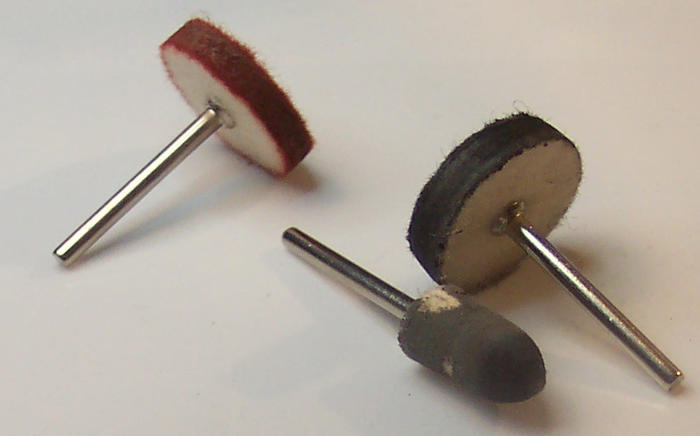Results 1 to 10 of 16
Hybrid View
-
05-27-2014, 02:31 AM #1
 How to use Dico compound on felt Dremel wheel?
How to use Dico compound on felt Dremel wheel?
I had a razor hand-sanded up to 1200. I'm new at this and am just trying things out for the first time. I tried polishing with Dico compounds, using a Dremel and felt buffer attachment. I used the sequence recommended on the Dico tube (E5, SCR, CR1). I set the Dremel at the lowest allowable speed (5,000 rpm). The buffer left scuff marks all over the blade. I finally had to sand them out.
Clearly, I'm doing something wrong with the buffer, but I'm not sure what. Any advice?
Joe
-
05-27-2014, 02:53 AM #2Senior Member

- Join Date
- Apr 2014
- Location
- Southern MO
- Posts
- 215
Thanked: 31
I can't speak to using a Dremel tool for polishing because I do mine by hand. You might try Flitz metal polish, it gives me great mirror finishes. If your blade has been sanded/polished to 1200 grit, Flitz will remove the satin (scratches) finish to a mirror shine.
-
05-27-2014, 02:56 AM #3

For one blade, I followed the advice on a Brad Maggard tutorial: finishing sanding up to 1500 grit, then thirty minutes with metal polish (I used Maas). But he sticks in some buffer time (white jeweler's rouge, if I remember correctly) between the 1500 grit and the metal polish.
Joe
Joe
-
05-27-2014, 03:05 AM #4Senior Member

- Join Date
- Apr 2014
- Location
- Southern MO
- Posts
- 215
Thanked: 31
That sounds like a good plan. If you don't achieve what you're looking for when you get to your final polish you can always back up and try a different product or approach. I'll sometimes use 3K grit paper with a light machine oil before final polish.
-
05-27-2014, 03:14 AM #5Senior Member




- Join Date
- Feb 2013
- Location
- Haida Gwaii, British Columbia, Canada
- Posts
- 14,454
Thanked: 4830
I use wet dry with WD-40 to 2K and then steel wool with mothers and then mothers. Wet dry is best with a backing, I use wine corks.
It's not what you know, it's who you take fishing!
-
05-27-2014, 03:17 AM #6

I was just looking at a couple of tutorials giving advice on different things you can use for backing--wine corks, rubber tubes, erasers, leather strips, wood blocks. Lots to choose from! One tutorial said use something hard (wood, for example) for the lower grits, then softer backings further up the line.
Joe
-
05-27-2014, 05:11 AM #7

I've also been using WD 40 with wet/dry. I'm not sure exactly why it seems to work better. Moves more easily, faster, and it makes a sort of paste, almost like slurry. Seems better than scraping dry grit across the blade.
This time around, not having a wine cork handy, I used a big rubber eraser as backing for the sandpaper. That worked well.
Joe
-
05-27-2014, 01:59 PM #8

[emoji33]I wouldn't use a Dremel to do anything on a straight razor. Just ain't safe!!
-
05-27-2014, 02:35 PM #9Senior Member



- Join Date
- Apr 2012
- Location
- Diamond Bar, CA
- Posts
- 6,553
Thanked: 3215
Are you using the ¼ inch felt wheels?
You have to keep them moving or they will dig in, better yet double them up to ½ inch you will just need a longer screw for your mandrel.
Get a 4mm sheet of craft foam, a dollar at a craft store and use that as a work surface, pressing on the blade with one hand will imbed the edge in the foam and there is no chance of the buffing wheel catching on the edge, you also cannot cut yourself if hand sanding.
Post of picture of your wheel set up.
Also use the slowest speed possible on the Dremel high speed, pressure and grit will gouge, keep it moving let the grit do the work not pressure.
You can use a Dremel, plenty of folks have and still do, slow speed and lots of caution. If thing go bad they go bad quickly. Be careful.
-
05-27-2014, 03:23 PM #10

The wheels are 1 inch in diameter and 3/8 in width. For the emery, I was also using a pointed felt tube that looks like the front end of a rocket ship:

Thanks. That's a good tip. I'm using a hardwood base with embedded rare-earth magnets. I tried putting self-adhesive felt over the magnets to keep them from scratching the blade. But I use WD 40 with wet and dry paper, and the felt got gunky fast. Took me a long time to clean off the glue from it. Now, I'm using a 1/8 inch thick sheet of plexiglass over the magnets. I'll try the foam.Get a 4mm sheet of craft foam, a dollar at a craft store and use that as a work surface, pressing on the blade with one hand will imbed the edge in the foam and there is no chance of the buffing wheel catching on the edge, you also cannot cut yourself if hand sanding.
I'll try again, keeping it moving, light touch. I had already been using the lowest rpm setting, which on this Dremel is 5,000.Also use the slowest speed possible on the Dremel high speed, pressure and grit will gouge, keep it moving let the grit do the work not pressure.
You can use a Dremel, plenty of folks have and still do, slow speed and lots of caution. If thing go bad they go bad quickly. Be careful.
Joe


 8Likes
8Likes LinkBack URL
LinkBack URL About LinkBacks
About LinkBacks






 Reply With Quote
Reply With Quote
